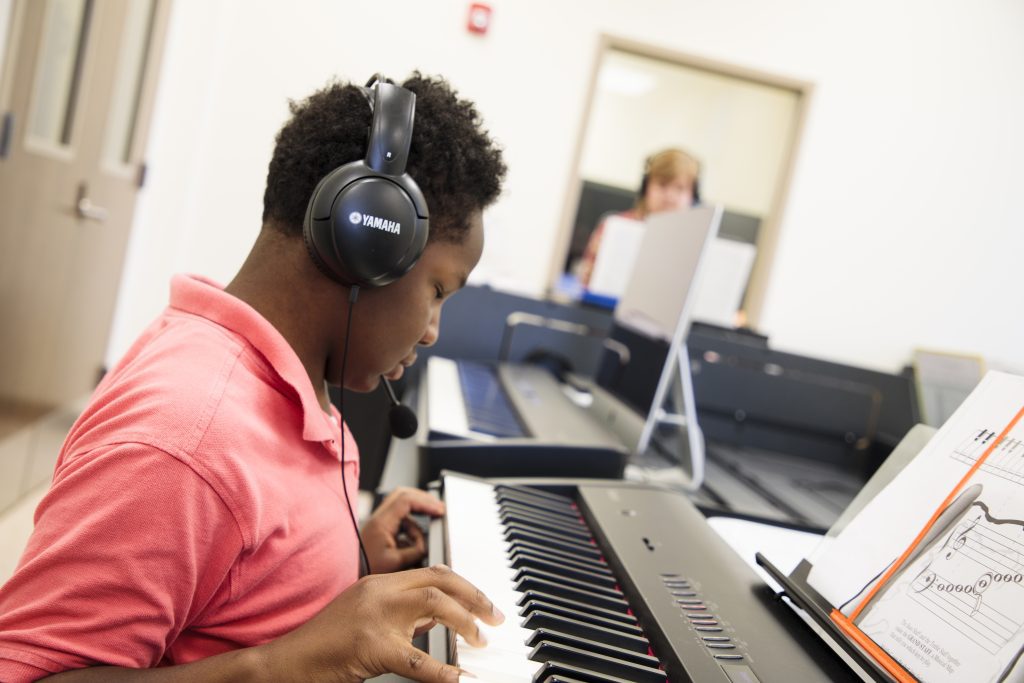APH Customer Service is closed until Monday, December 2nd.
To ensure gift delivery by 12/25, please place orders via UPS shipping no later than 12/17.
CloseAPH Customer Service is closed until Monday, December 2nd.
To ensure gift delivery by 12/25, please place orders via UPS shipping no later than 12/17.
Close
At our October Connect the Dots event held at the Western Louisville Free Public Library, families had the opportunity to explore the world of sound and vibration. Sense of sound and touch can be very important for someone who is blind or low vision because they allow them to learn about and connect with the world around them. With the guidance of blind and sighted leaders from the American Printing House for the Blind, families got hands-on with a variety of high and low-tech devices to learn more about how these tools help people who are blind or low vision navigate school, work, and everyday life.
The first activity station introduced the science of sound. Sound travels nearly invisibly through the air, but sometimes we can see the vibrating sources of sound like when we watch the strings of an instrument dance up and down. At this station participants played with a homemade tool called “oobleck”, a mixture of cornstarch and water, that when placed on a speaker would move based on the sound vibration waves coming from the device.
At the next station participants watched clips of shows with audio description to learn about how it helps blind or low vision individuals access information and entertainment. Sometimes called “video description” or simply “description”, audio description helps people who are blind or low vision gain more comprehensive access to the creative content of TV programs and movies. As a part of our accessible design standards, there will be audio description throughout our new museum, The Dot Experience, to give all visitors access to visual content.
At the third station participants got to listen to Talking Books recorded by APH Narrators. Similar to audio books, Talking Books are especially designed for people who are blind, low vision, or otherwise unable to access print material. Unlike audio books, Talking Books are available at no cost through the National Library Service. The next station featured APH’s musical braille code product, the Music Braille Wheel. Music Braille Code provides blind or low vision people access to read and write music independently. Because the Music Braille Code is a code, not a language, a decoder tool like the Music Braille Wheel can be used to decipher braille by first-time music braille learners.
Finally, the last station focused on vibrations and how they can be felt through the sense of touch. At this station, participants learned how to use a white cane and its vibrations to sense and navigate the world around them. This station featured one of The Dot Experience cast member’s, Anthony Ferraro. Anthony is an Olympic athlete and one of the hosts of Four Bad Eyes, a podcast which demystifies blindness through candid conversations, special guests, and humor. He uses his white cane to navigate skateparks to land trick after trick. Sometimes he rides his skateboard behind his white cane, making decisions in real time on where and how to travel next. Other times, Anthony uses his white cane to make a mental map of the skatepark so he can skateboard without his cane in order to land more difficult tricks.
We only have two more Connect the Dots events left in 2024! Mark your calendars and be sure to follow The Dot Experience on Facebook and X for updates on the museum.

Chipping away at the backlog of unprocessed collections (there’s always a backlog in archives), I came across four spiral-bound volumes...

Want to support your student’s budding interest in music? We’ve got you covered. Get moving and grooving with this list...

Authors: Sarah Welch, Product Specialist; Laura Zierer, Product Manager Schools are getting ready to start back after summer break, and...